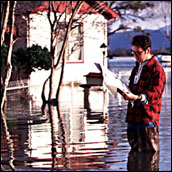

 |
||
| by John Weier - July 2, 1999 |
||
| Millions of people in the United States and around the world have no idea that they
live on a floodplain. Worse yet, they probably will not find out until it’s too late. Their ignorance does
not stem from crooked developers or shady land deals, but from a lack of cartography. Very few extreme,
one-hundred-year floods are mapped out as they occur. Since these natural events are so rare and cover such
a large area, people lose track of which lands were flooded. Without the benefit of historical records,
residents build on ground that once was and may again be underwater. Geomorphologist Bob Brakenridge and a
team of scientists at Dartmouth College are working to correct this situation. For the past four years
they have been searching the world with orbiting imaging satellites, trying to spot extreme floods. When
the members of the team identify a fifty-year flood or a hundred-year flood, they obtain an image of the
inundated area with the satellites’ sensors. From these images the scientists create floodplain maps,
which they then catalog on a database for everyone to use. The team’s efforts have already helped
hydrologists and floodplain managers to better understand floods. In the future, the techniques
Brakenridge and his colleagues develop could allow people to see extreme floods as they progress in real
time. |
 A worker from the Federal Emergency Management Agency (FEMA) inspects flood damage in Clear Lake, California. (Photograph by Andrea Booher and Greg Mathieson, FEMA Emergency Information and Media Affairs) |
|

The data used in this study are available in one or more of NASA's Earth Science Data Centers. |
Advanced Very High Resolution Radiometer images before (left) and during (right) a flood in Northern Russian, near the Barents Sea. Ice flows formed during the unusually cold winter of 1997-98 and blocked the mouth of the Pechora River, flooding several towns. Scientists used the data to make a map of the flood. (Images by E. Anderson and R. Brakenridge, Dartmouth Flood Observatory) |
|